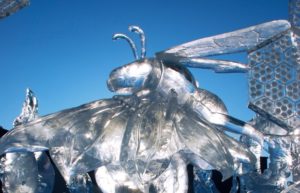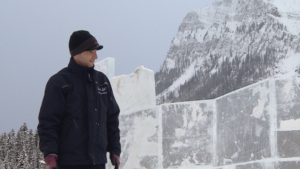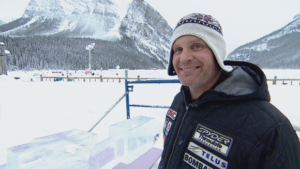Free from bubbles and impurities, ‘this is not the ice you have in your martinis,’ says competitor Ken Harper

It’s not the sexiest part of Lake Louise’s iconic ice carving competition, but to many of the international competitors, it’s the part that matters most.
For more than 20 years, the Ice Magic Festival has drawn top-tier ice artists and spectators from around the world with its sparkling, intricate designs.

But the frozen extravaganza is as much engineering as it is art, and none of it would be possible without the right ice.
With final sculptures that could weigh more than 2,000 kilograms, it should be obvious why the ice’s structural integrity is just as important as its esthetic quality.
There’s a science to how the ice is created, in pursuit of the purest, clearest and most stable medium possible.

How the ice is made
“This is not the ice you have in your martinis,” said Canadian competitor Ken Harper.
Regular ice generally appears cloudy because of air that gets trapped during the freezing process. Because ice is typically chilled from the outside in, bubbles typically concentrate in the centre of the block.
To prevent those air pockets, Lake Louise’s competition-grade ice is formed in a special freezer and frozen from the bottom up.
A water pump and a rotating float keep the water circulating gently, pushing any bubbles and impurities to the still-liquid top of the ice.
This process continues for two to three days. Then the ice block is given time to freeze completely, and the top layer with all of its trapped gas and particles is sawed off.
The remaining ice is put through a “giant band saw,” which cuts standard chunks, 10 inches high, 20 inches wide and 40 inches long, Harper explained.
With graph paper in hand
But the science doesn’t stop once the ice is created.
Particularly on Day 1, competitors must pay close attention to the laws of physics. Each team is given 15 blocks and is responsible for hoisting the 135-kg masses into stacks, cutting and re-freezing as they go.

“This is the most crucial part of our ice-carving exhibit here, because if we don’t do this correctly, we could have some structural issues,” said Ken Harper, standing beside an ice tower weighing roughly 1,300 kg.
Like some of his co-competitors, Harper is as familiar with graph paper, pencil and ruler as he is with chainsaw, chisel and grinder.
He has spent hours planning and re-calculating how best to stack, cut and freeze the blocks back together, depending on the outside temperature and the ultimate shape of the sculpture he has envisioned.
Apply too much water as adhesive, and the block could literally explode, warned another Canadian competitor, Rusty Cox. He speaks from personal experience.
But by Day 2, the ice stacks have been given sufficient time to set, and the more intricate carving begins to take place.
If all goes according to plan, Cox and his teammate Steve Buzak will be using their $7,000 worth of tools to create a heli-skiing sculpture, complete with mountain, ski slope, skier and small-scale replica of a Bell 212, two-blade, twin-engine helicopter.
The pair represent this year’s only all-Canadian team in the running.
Set in front of the Chateau Fairmont in picturesque Lake Louise, the annual Ice Magic festival is one of the three annual Canada Cup competitions.
This year’s theme, “All in the Wild,” has drawn competitors from China, Poland, France and the United States.
The winner will automatically win a spot at all 2019 Canada Cup events.


